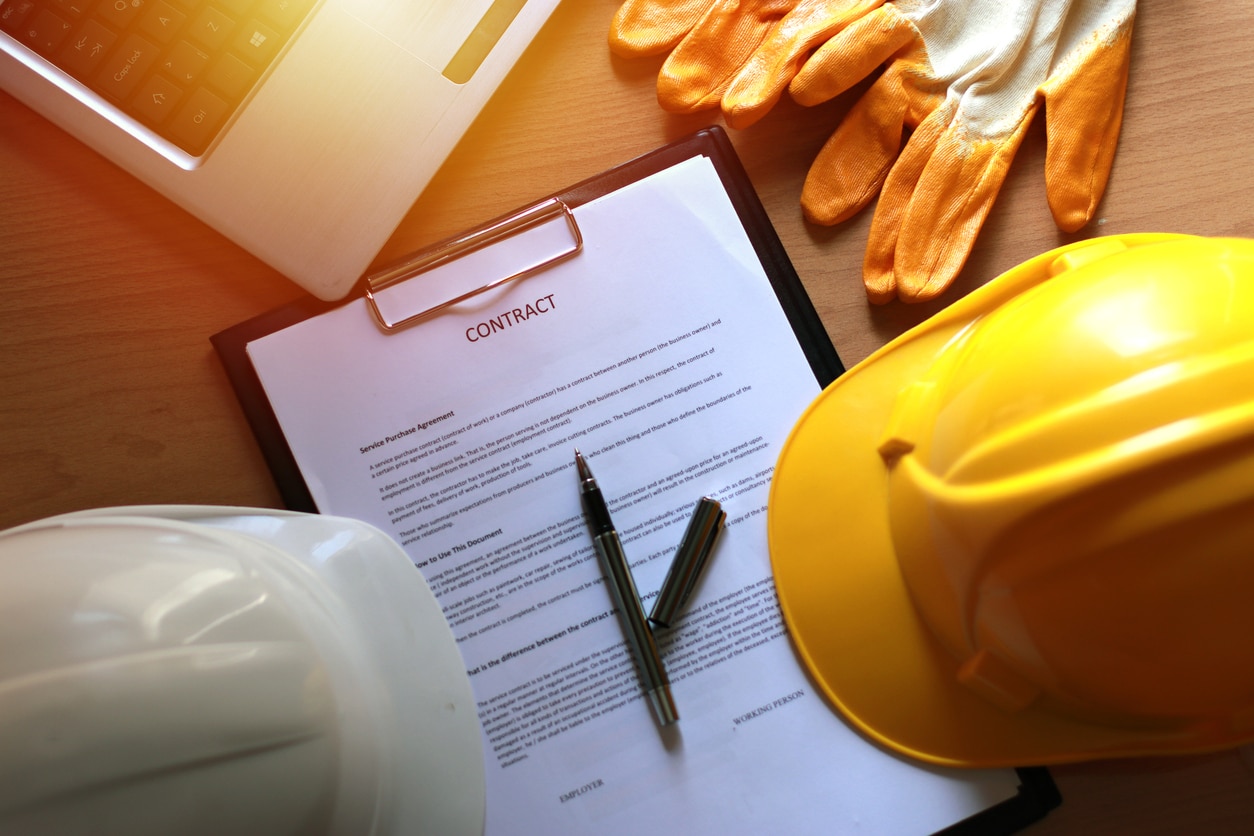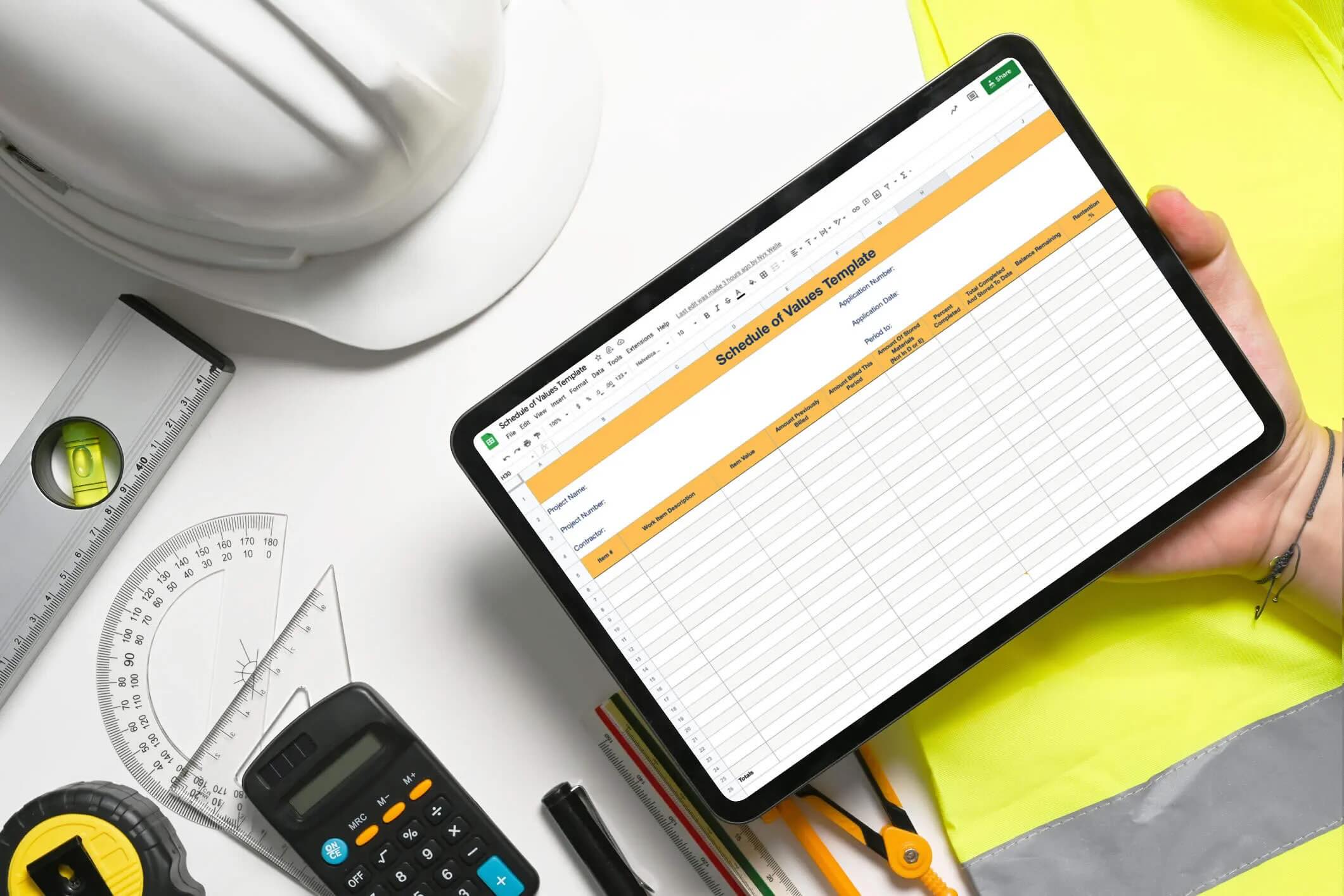Home>diy>Building & Construction>How To Make A Contract For Construction


Building & Construction
How To Make A Contract For Construction
Modified: January 4, 2024
Learn how to create a comprehensive contract for building construction projects and protect your interests. Expert tips on drafting and finalizing construction contracts.
(Many of the links in this article redirect to a specific reviewed product. Your purchase of these products through affiliate links helps to generate commission for Storables.com, at no extra cost. Learn more)
Introduction
Welcome to the world of construction contracts! In the building industry, contracts are essential for establishing clear expectations, protecting the rights of all parties, and ensuring a successful project completion. Whether you are a contractor, subcontractor, or property owner, understanding how to create a comprehensive and effective construction contract is vital.
A construction contract serves as a legally binding agreement between the contractor and the client, outlining the terms and conditions of the project. It establishes the rights, responsibilities, and obligations of each party involved, including project scope, timelines, payment terms, and dispute resolution procedures. By having a well-drafted contract in place, you can minimize misunderstandings, manage risks, and ultimately build a solid foundation for a successful construction project.
In this guide, we will walk you through the key steps to create a contract for construction that covers all the necessary aspects of your project. From understanding the project scope to finalizing and signing the contract, we will provide you with valuable insights and tips to ensure a smooth and transparent contractual process.
Before we dive into the details, it’s important to note that while this guide provides a general framework for construction contracts, it doesn’t replace professional legal advice. Every construction project is unique, and you may need to consult with an attorney to tailor the contract to your specific needs and comply with local laws and regulations.
Now, let’s start our journey towards creating an effective construction contract!
Key Takeaways:
- Clear and comprehensive construction contracts are vital for successful projects, minimizing disputes, and establishing a solid foundation for collaboration and accountability between all parties involved.
- Thorough understanding of project scope, clear identification of parties, appropriate contract type selection, and inclusion of payment terms, project timeline, scope of work, quality standards, change orders, insurance and liability, dispute resolution, and termination clauses are key elements to consider when creating a construction contract.
Read more: How To Get Contracts For Construction
Understand the Project Scope
A crucial first step in creating a construction contract is to thoroughly understand the project scope. The project scope outlines the specific details of what needs to be accomplished and delivered. As a contractor or property owner, it’s essential to have a clear understanding of the project scope before drafting the contract.
Start by reviewing the project plans, specifications, and any other relevant documents. Identify the key deliverables, such as the type of building, the size, the number of floors, and any additional features. Consider any special requirements or customizations that may affect the overall scope of work.
Next, define the specific tasks and responsibilities of both parties. This includes identifying the work to be performed by the contractor, as well as any contributions or actions required from the property owner or other stakeholders. Be as detailed as possible to eliminate ambiguity and ensure that all parties have a clear understanding of their roles and responsibilities.
In addition to the physical aspects, it’s important to consider any legal or regulatory requirements that may impact the project scope. Determine if there are any permits, licenses, or certifications needed and specify who will be responsible for obtaining them. This could include building permits, environmental permits, or specialized certifications for certain types of construction work.
Lastly, be aware of any potential risks or challenges that may arise during the project. This can include factors such as adverse weather conditions, site restrictions, or unforeseen circumstances that may affect the timeline or cost of the project. Addressing these risks upfront and including provisions for handling them in the contract can help mitigate any future disputes.
By thoroughly understanding the project scope, you can ensure that the contract accurately reflects the goals, requirements, and expectations of the project. Establishing a clear and comprehensive scope of work sets the foundation for a successful construction project and reduces the likelihood of disputes or misunderstandings later on.
Identify the Parties Involved
In any construction contract, it is crucial to identify the parties involved and clearly define their roles and responsibilities. This helps to establish a clear understanding of who is entering into the agreement and what their obligations are throughout the project. Let’s take a closer look at how to identify the parties in a construction contract.
The primary parties involved in a construction contract are the contractor and the client. The contractor is the entity responsible for carrying out the construction work, while the client is the owner of the property or the entity procuring the construction services.
When identifying the contractor, provide their legal business name, address, and contact information. It’s also essential to include details about their license, certifications, and insurance coverage, if applicable. This helps to ensure that the contractor has the necessary qualifications and protections in place to perform the work.
The client may be an individual property owner, a business, or a government entity. Clearly state the client’s full name, address, and any relevant contact information. If the client is represented by a project manager or a designated contact person, include their details as well.
In addition to the contractor and client, there may be other parties involved in the construction project. This can include architects, engineers, subcontractors, suppliers, or consultants. Identify these parties in the contract and outline their specific roles and responsibilities.
When including additional parties in the contract, provide their legal business names, addresses, and contact information. Specify the scope of work and any contractual obligations they have. It is important to clearly communicate how these parties will interact and collaborate with the primary contractor and client.
By identifying all parties involved and clearly defining their roles, you establish a framework for effective communication and collaboration throughout the project. This helps to minimize confusion and ensures that everyone understands their responsibilities and obligations. It also allows for proper documentation and accountability if any disputes or issues arise during the construction process.
Determine the Contract Type
When creating a construction contract, it’s important to determine the appropriate contract type that suits the needs of the project. The contract type defines the nature of the relationship between the contractor and the client, as well as the allocation of risks and responsibilities. Let’s explore some common contract types used in the construction industry.
1. Fixed-Price Contract: Also known as a lump-sum contract, this type of contract specifies a fixed price for the entire project. The contractor agrees to complete the work for a predetermined amount, regardless of any changes or unforeseen circumstances that may arise. Fixed-price contracts provide a clear and predictable cost for the client but may require thorough planning and detailed specifications upfront.
2. Cost-Plus Contract: In a cost-plus contract, the client agrees to reimburse the contractor for the actual costs of labor, materials, and other direct expenses, along with an agreed-upon fee or percentage for overhead and profit. This contract type is commonly used when the project scope or requirements are uncertain, and it allows for flexibility in accommodating changes during the construction process. However, it can result in higher costs for the client.
3. Time and Material Contract: This contract type combines elements of both fixed-price and cost-plus contracts. The client pays the contractor based on the actual hours of labor, materials used, and any agreed-upon markups or fees. Time and material contracts are commonly used for smaller-scale projects or when the project scope is not well-defined. It offers flexibility but may lead to uncertainty in terms of final costs.
4. Unit Price Contract: Unit price contracts are used when the project involves repetitive or standardized work, such as road construction or utility installations. The contract specifies a unit price for each item or task, and the total cost is determined by multiplying the unit price by the quantity of work completed. This type of contract provides transparency in pricing but may require accurate measurement and documentation.
5. Design-Build Contract: In a design-build contract, the contractor is responsible for both the design and construction of the project. This contract type streamlines the communication and coordination between the designer and the builder, reducing potential conflicts. Design-build contracts are popular for complex projects as they can speed up the construction process and potentially save costs.
When selecting the contract type, consider factors such as the project size, complexity, timeline, and degree of certainty in the project scope. It’s crucial to consult with legal counsel or construction professionals to determine the most suitable contract type for your specific project.
By choosing the appropriate contract type, you can establish a fair and balanced framework that aligns with the project requirements and minimizes potential risks and disputes.
Include Payment Terms
One of the most critical aspects of a construction contract is the inclusion of clear and comprehensive payment terms. The payment terms outline how and when the contractor will be compensated for their work, materials, and any additional expenses. Including well-defined payment terms ensures transparency and helps prevent payment disputes during the construction project. Here are some key elements to consider when including payment terms in your construction contract:
1. Payment Schedule: Specify the agreed-upon payment schedule, including the timing and frequency of payments. This may include milestones or progress-based payments, where the contractor receives a portion of the payment upon achieving specific project milestones or completing certain stages of the work. Clearly state the due dates and any penalties for late payments.
2. Retention or Holdback: In some cases, a retention or holdback clause may be included in the contract. This allows the client to withhold a portion of the payment until the satisfactory completion of the project, including any necessary rectification or warranty periods. The retention amount is typically a percentage of the total contract value and is released upon final completion and acceptance of the work.
3. Payment Method: Specify the preferred method of payment, whether it’s through checks, wire transfers, or electronic payment platforms. State the details and instructions necessary for the contractor to receive payment in a timely manner.
4. Additional Costs and Change Orders: Address how additional costs and change orders will be handled. Change orders refer to any modifications or alterations to the original scope of work that result in additional expenses. Clearly state the process for approving and documenting change orders, including the impact on the project timeline and payment terms.
5. Disputed Payments: Establish a procedure for handling disputes related to payment. Outline the steps to be taken in the event of non-payment or disagreement over payment amounts. This may include mediation, arbitration, or legal remedies available to either party.
6. Specific Payment Conditions: Depending on the nature of the project, there may be specific payment conditions that need to be addressed. For example, if the contractor is required to purchase significant materials upfront, consider specifying how reimbursement for material costs will be handled.
It’s important to ensure that your payment terms comply with local laws and regulations. In some jurisdictions, there may be specific requirements regarding prompt payment, retention amounts, or lien rights that need to be included in the contract.
By including clear and transparent payment terms in your construction contract, you establish a solid foundation for a fair and mutually beneficial working relationship. This helps to avoid payment disputes and creates a positive atmosphere for the successful completion of the project.
Read more: What Is A Construction Contract
Outline Project Timeline
A well-defined project timeline is essential in a construction contract as it establishes expectations and deadlines for the completion of various project milestones. Having a clear outline of the timeline helps ensure that all parties involved are on the same page and can effectively plan and manage the construction project. Here are some key considerations when outlining the project timeline in your construction contract:
1. Start Date: Clearly specify the anticipated start date of the project. This is the date when the contractor will commence work on the project, and it sets the foundation for the entire timeline. Consider allowing some flexibility for unforeseen circumstances that may cause a slight delay in the start date.
2. Completion Date: Include a realistic completion date for the entire project. This is the date by which the contractor commits to finishing all the work outlined in the contract. It is important to account for adequate time for inspections, testing, and any necessary corrections or revisions.
3. Milestones: Break down the project timeline into specific milestones or phases. These milestones define key stages of the project and help track progress. Typical milestones may include completing foundation work, finishing structural framing, plumbing and electrical installations, and finalizing interior finishes. Clearly indicate the anticipated dates for each milestone.
4. Project Schedule: Provide a detailed schedule or timeline chart that outlines the sequencing of various tasks and activities. This helps give a visual representation of the project’s progression and allows both the contractor and client to understand the overall flow of work. Consider using project management software or tools to create a comprehensive schedule.
5. Flexibility and Contingencies: Acknowledge that construction projects can encounter unforeseen delays or changes. Include provisions for extensions to the timeline in case of unforeseen circumstances such as weather disruptions, material shortages, or design adjustments. Also, outline the process for addressing these changes and how they may impact the project timeline and costs.
6. Reporting and Communication: Specify regular reporting and communication procedures. This ensures that progress updates and any potential deviations from the timeline are promptly communicated between the contractor and client. It may include weekly or monthly progress reports, site meetings, or scheduled updates on project milestones.
By outlining a comprehensive project timeline, you create a roadmap that guides the construction project from start to finish. It facilitates effective planning, coordination, and monitoring of the project, contributing to its successful completion within the agreed-upon timeframe.
Specify Scope of Work
Defining the scope of work is a critical aspect of a construction contract as it sets the boundaries and expectations for what will be included in the project. Clearly specifying the scope of work ensures that both the contractor and the client have a shared understanding of the tasks and deliverables involved. Here are some key points to consider when specifying the scope of work in your construction contract:
1. Project Description: Begin by providing a detailed description of the project. Include information about the type of construction, such as residential, commercial, or industrial, and any unique features or requirements. Describe the purpose or intended use of the building or structure being constructed.
2. Architectural and Engineering Drawings: Reference any architectural or engineering drawings that provide a visual representation of the project design. This includes floor plans, elevations, structural drawings, and any other relevant documents. Make sure to indicate that the contractor is responsible for adhering to these plans and specifications.
3. Materials and Specifications: Outline the materials and finishes expected for various elements of the project, such as flooring, roofing, plumbing fixtures, and electrical systems. Specify any required standards or certifications for the materials to ensure compliance with building codes and regulations.
4. Construction Tasks: Indicate the specific tasks to be performed by the contractor. This includes activities such as site preparation, excavation, foundation construction, framing, installation of mechanical systems, finishing work, landscaping, and any other relevant construction tasks. Break down the scope of work into clear and actionable items.
5. Exclusions: It’s equally important to define what is NOT included in the scope of work. This helps to prevent misunderstandings and disputes in the future. Clearly state any exclusions or items that are the responsibility of the client or other parties, such as obtaining permits, conducting environmental assessments, or providing specialized equipment.
6. Approvals and Inspections: Specify the process for obtaining necessary approvals and inspections from relevant authorities, such as building inspections or fire safety inspections. Indicate who is responsible for coordinating and executing these inspections and highlight the role of the contractor in meeting regulatory requirements.
7. Workmanship and Quality Standards: Clearly outline the expected workmanship and quality standards for the construction project. This includes adherence to applicable building codes, industry standards, and any specific requirements outlined in the contract documents. Emphasize the importance of delivering work of a consistently high standard and define the procedures for addressing any deficiencies or non-compliance.
By specifically defining the scope of work, you ensure that all parties have a clear understanding of the tasks, deliverables, and quality standards involved in the construction project. This helps to avoid confusion, reduces the likelihood of disputes, and facilitates a smooth and successful project execution.
Include clear and detailed descriptions of the project scope, timeline, payment terms, and any potential changes or disputes in your construction contract to avoid misunderstandings and legal issues.
Establish Quality Standards
Establishing clear quality standards is essential in a construction contract to ensure that the work meets the expected level of quality and craftsmanship. Defining these standards helps set the foundation for a successful project that meets the client’s expectations. Here are some key considerations when establishing quality standards in your construction contract:
1. Building Codes and Regulations: Begin by stating that all construction work will comply with applicable building codes, regulations, and standards. This ensures that the project meets the minimum safety and quality requirements set by the governing authorities.
2. Industry Standards: Specify that all work will be performed in accordance with industry best practices and recognized construction standards. Refer to relevant industry guidelines or standards, such as those set by professional associations or organizations, to ensure a consistent level of quality throughout the project.
3. Materials and Products: Outline the expectations for the quality of materials and products to be used in the construction. Define any specific requirements or standards that the materials must meet, such as durability, fire-resistance, energy efficiency, or environmental sustainability. This helps to ensure that the project is constructed using high-quality components.
4. Workmanship: Clearly state the expected level of workmanship and craftsmanship for the construction project. Define the quality standards for various aspects of the work, such as framing, electrical installations, plumbing, finishing, and any specialized trades. Specify that all work will be carried out by qualified and experienced professionals to ensure a high level of expertise and attention to detail.
5. Inspections and Testing: Include provisions for inspections and testing to verify the quality of the work. Outline the process for conducting regular site inspections and any required third-party inspections or tests, such as structural testing or electrical safety checks. Establish that any defects, deficiencies, or non-compliance will be promptly addressed and remedied.
6. Warranty and Guarantees: Discuss warranty and guarantee provisions to provide assurance to the client. Specify the duration and coverage of any warranties, as well as the process for making warranty claims. This helps to establish confidence in the quality of the work and the contractor’s commitment to long-term customer satisfaction.
7. Change Orders and Quality Control: Address how any changes or modifications to the original scope of work will be handled without sacrificing the established quality standards. Clearly state that any changes must meet the same level of quality and workmanship as the original contracted work. Implement a stringent quality control process to ensure that all changes are properly assessed, approved, and executed.
By establishing clear quality standards, you set the expectation for a construction project that adheres to the highest level of workmanship and meets all relevant codes and regulations. This helps to ensure that the final result not only meets the client’s satisfaction but also stands the test of time in terms of durability and functionality.
Address Change Orders
Change orders are an inevitable part of the construction process, as projects often require adjustments or modifications to the original scope of work. To effectively address change orders in your construction contract, it is crucial to establish clear guidelines and procedures. This helps to minimize disputes, maintain project momentum, and ensure that any changes are properly documented and executed. Here are some key considerations when addressing change orders in your construction contract:
1. Definition and Authorization: Begin by defining what constitutes a change order. Specify that a change order refers to any alteration, addition, or omission to the original scope of work outlined in the contract. Clearly state that change orders must be authorized in writing by both the client and the contractor to be considered valid.
2. Change Request Process: Outline the process for requesting a change order. Define how clients must communicate their change requests, whether through written forms, email, or another agreed-upon method. Specify the timeframe for submitting change requests and any relevant documentation or specifications required to evaluate the change.
3. Evaluation and Approval: Establish a procedure for evaluating and approving change orders. Define who will assess the feasibility, impact, and cost implications of the proposed change, which may involve the contractor, architect, or project manager. Emphasize that change orders will only be approved if they are within the agreed-upon budget and timeline and do not compromise the overall project objectives.
4. Cost and Time Adjustments: Clearly state how cost and time adjustments will be determined for approved change orders. Outline the method for calculating the cost implications of the change, taking into account labor, materials, and any additional expenses. Specify whether there will be a markup or a fee associated with managing the change order process. Address how the change order may impact the project timeline and specify any adjustments to the completion date.
5. Documentation and Record Keeping: Emphasize the importance of maintaining detailed documentation for all change orders. Specify that all change orders must be recorded in writing, signed by both parties, and attached as addendums to the original contract. Include a process for organizing and documenting any amendments or revisions to the project plans, specifications, or drawings resulting from approved change orders.
6. Communication and Transparency: Stress the importance of open and transparent communication in the change order process. Require regular updates and discussions between the contractor and client regarding any proposed changes. Encourage both parties to collaborate and find mutually agreeable solutions to ensure that change orders are implemented efficiently and effectively.
7. Dispute Resolution: Address the process for resolving any disputes that may arise in relation to change orders. Include provisions for mediation, arbitration, or any other agreed-upon method of dispute resolution. Highlight the importance of resolving disputes promptly to maintain project progress and minimize disruptions.
By addressing change orders in your construction contract, you establish a framework for managing changes effectively and navigating any potential complexities that may arise during the construction process. This helps to maintain trust, transparency, and accountability between the contractor and the client throughout the project.
Include Insurance and Liability Information
When creating a construction contract, it’s crucial to address insurance and liability to protect both the contractor and the client. Including comprehensive insurance and liability provisions in the contract helps to mitigate risks, ensure financial protection, and establish clear responsibilities in the event of accidents, property damage, or other unforeseen events. Here are some key considerations when including insurance and liability information in your construction contract:
1. General Liability Insurance: Specify that the contractor must maintain a valid general liability insurance policy during the duration of the project. This insurance coverage protects against third-party claims for bodily injury, property damage, or personal injury that may occur during the construction process. Clearly define the required coverage limits and stipulate that the contractor must provide evidence of the insurance before commencing work.
2. Workers’ Compensation Insurance: Address the requirement for the contractor to carry workers’ compensation insurance to protect their employees. This coverage provides benefits to workers in the event of work-related injuries or illnesses. Ensure that the contractor agrees to comply with all applicable workers’ compensation laws and regulations.
3. Property Insurance: Specify that the client is responsible for maintaining property insurance that covers the construction site and any existing structures. This insurance should provide comprehensive coverage for risks such as fire, theft, vandalism, and natural disasters. Indicate that the contractor is not liable for any damages or losses to the property unless caused by their negligence or intentional misconduct.
4. Subcontractor Insurance: Specify that the contractor is responsible for ensuring that any subcontractors they hire also carry appropriate insurance coverage, including general liability and workers’ compensation insurance. This protects both the contractor and the client from potential liability arising from the subcontractor’s work.
5. Indemnification: Include an indemnification clause that outlines the contractor’s obligation to defend, indemnify, and hold harmless the client from any claims, damages, or losses arising from the performance of the construction work. This helps transfer the responsibility for any liabilities or damages caused by the contractor to the contractor themselves.
6. Limitation of Liability: Clearly define the limit of liability for both the contractor and the client. Specify that neither party shall be liable for any indirect, consequential, or special damages. This helps protect both parties from excessive financial exposure and ensures that any disputes are resolved within reasonable bounds.
7. Notice of Claims: Establish a procedure for giving notice of claims related to insurance or liability issues. Specify the timeframe within which such claims should be reported and the required form and content of the notice. This ensures that both parties are promptly notified of any potential claims and can take appropriate action in a timely manner.
It’s important to consult with legal and insurance professionals to ensure that the insurance and liability provisions in your construction contract accurately reflect the specific requirements and regulations of your jurisdiction. Having adequate insurance coverage and clearly outlining liability responsibilities protects the interests of all parties involved and provides peace of mind throughout the construction project.
Discuss Dispute Resolution
While it’s always preferable to have a smooth and collaborative construction process, disputes can sometimes arise. To address potential conflicts and establish a framework for resolving them, it’s essential to include a clause on dispute resolution in your construction contract. A robust dispute resolution process helps to minimize disruptions, maintain project momentum, and mitigate the costs and time associated with lengthy legal proceedings. Here are some key considerations when discussing dispute resolution in your construction contract:
1. Mediation: Include a provision for mediation as the initial step in resolving any disputes. Mediation involves hiring a neutral third party, typically a mediator with experience in construction disputes, who facilitates communication and negotiation between the parties. Clearly state that mediation is a mandatory process before resorting to more formal legal action. Outline the timeline and selection process for choosing a mediator, as well as the costs and responsibilities associated with mediation.
2. Arbitration: If mediation fails to resolve the dispute, provide for arbitration as the next step. Arbitration involves submitting the dispute to one or more impartial arbitrators who act as private judges and render a binding decision. Specify that arbitration will be conducted in accordance with recognized arbitration rules, such as those established by the American Arbitration Association (AAA) or the International Chamber of Commerce (ICC). Define the number of arbitrators, the location of the arbitration, and any limitations on the scope of the arbitration process.
3. Litigation: In the event that mediation and arbitration do not result in a satisfactory resolution, address the option of pursuing litigation in a court of law. Clearly state the jurisdiction and venue where any legal proceedings would take place. Define any limitations on the right to file claims or lawsuits, such as requiring prior attempts at mediation or arbitration.
4. Legal Costs and Attorney’s Fees: Specify which party will be responsible for bearing the costs associated with dispute resolution. This includes mediation fees, arbitration costs, court filing fees, and attorney’s fees. Consider including a provision that the prevailing party in any dispute is entitled to reimbursement of their reasonable legal costs and expenses.
5. Collaboration and Good Faith: Emphasize the importance of collaboration and good faith efforts in resolving disputes. Require both parties to engage in sincere and reasonable attempts to resolve conflicts before escalating to mediation or arbitration. This encourages open communication and a proactive approach to finding mutually agreeable solutions.
6. Suspension of Work: Address the process for addressing disputes that may disrupt the progress of the construction project. Specify the conditions under which work may be temporarily suspended during the resolution process and outline the steps necessary to resume work once the dispute is resolved. This helps to ensure that the project does not come to a complete standstill in the midst of a dispute.
7. Severability: Include a severability clause stating that if any provision in the dispute resolution section of the contract is found to be invalid or unenforceable, it will not affect the validity or enforceability of the remaining provisions. This provides assurance that the other dispute resolution mechanisms will still be in effect even if one provision is deemed unenforceable.
By addressing dispute resolution in your construction contract, you establish a fair and structured process to handle any disagreements that may arise during the project. This promotes open communication, fosters collaboration, and helps maintain project progress while protecting the interests of all parties involved.
Include Termination Clause
A termination clause is a vital component of any construction contract as it outlines the conditions under which the contract may be ended by either party before the completion of the project. Including a well-crafted termination clause provides clarity, protects the rights of both the contractor and the client, and establishes procedures for an orderly termination of the contract. Here are some key considerations to include in the termination clause of your construction contract:
1. Termination for Convenience: Specify that either party has the right to terminate the contract for convenience. This allows for termination without fault or cause, typically with prior written notice. Define the required notice period for termination and any compensation or reimbursement that may be payable upon termination, such as the fair value of work completed or costs incurred up to the termination date.
2. Termination for Cause: Outline the circumstances under which either party may terminate the contract for cause. This typically involves a material breach of contract by one party, such as non-performance, failure to meet quality standards, or failure to adhere to project timelines. Clearly state the specific triggering events that constitute a cause for termination, as well as any required notice and cure period before termination can occur.
3. Termination Procedures: Establish the procedures and obligations that must be followed in the event of termination. Specify which party is responsible for notifying the other party of the intent to terminate and how the termination notice should be delivered. Address the requirements for winding down the project, including the orderly transfer of project documentation, intellectual property, and any materials or equipment.
4. Payment upon Termination: Address the financial aspects of termination in the contract. Specify any payment obligations owed by either party upon termination, such as outstanding payments for work completed or costs incurred up to the termination date. Define any penalties or liquidated damages that may be applicable in the event of termination for cause, and the process for calculating and settling these amounts.
5. Responsibilities upon Termination: Clearly outline the responsibilities of both the contractor and the client upon termination. Address the obligations for securing the construction site, returning any borrowed equipment or materials, and ensuring compliance with applicable laws and permits. Specify any post-termination obligations, such as warranties or guarantees that extend beyond the termination date.
6. Dispute Resolution: Include provisions for resolving any disputes related to the termination of the contract. Specify the process for mediation, arbitration, or litigation if either party disagrees with the termination or the financial and contractual obligations associated with it.
7. Survival of Certain Clauses: Address which clauses of the contract will survive termination. Certain provisions, such as those related to confidentiality, indemnification, or intellectual property rights, may need to remain in effect even after the contract termination to protect the interests of both parties.
By including a well-drafted termination clause in your construction contract, you provide a clear framework for ending the contract, protecting the rights and interests of all parties involved. This helps to minimize disputes and ensures a fair and orderly termination process in both planned and unexpected situations.
Finalize and Sign the Contract
Once you have diligently addressed all the necessary elements in your construction contract, it’s time to finalize the document and proceed with the important step of signing the contract. Finalizing and signing the contract solidifies the agreement between the contractor and the client, providing a clear roadmap for the successful completion of the construction project. Here are some key steps to follow when finalizing and signing the contract:
1. Review and Editing: Before presenting the contract for signature, conduct a thorough review to ensure that all provisions are accurate, complete, and correctly reflect the agreements reached between the parties. Check for any inconsistencies, typographical errors, or ambiguous language that may lead to misunderstandings. Make any necessary edits or revisions to the contract to address these issues and ensure clarity.
2. Legal Review: Consider seeking legal counsel to review the contract to ensure compliance with local laws, regulations, and industry-specific requirements. Professional legal guidance can help identify any potential risks or gaps in the contract and provide recommendations for strengthening its enforceability. Address any concerns or suggestions from the legal review to strengthen the integrity of the contract.
3. Copy Distribution: Once the contract is finalized, prepare multiple copies for distribution. Provide each party with an original signed copy of the contract, and retain additional copies for record-keeping purposes. Consider providing electronic copies as well for ease of reference and accessibility.
4. Execution of Signatures: Schedule a meeting or arrange for the parties to sign the contract in the presence of witnesses, if required by local laws. Ensure that all parties with signing authority are present or represented, and that they understand and agree to the terms of the contract. Sign the contract using ink signatures to indicate full acceptance and commitment to its terms.
5. Notarization: Depending on the jurisdiction and the complexity of the contract, you may consider getting the contract notarized. Notarization involves a certified notary public verifying the authenticity of the signatures and ensuring that the parties signing the contract are who they claim to be. Notarization adds an additional layer of legal validity and can be beneficial in certain situations.
6. Document Retention: After the contract is signed, create an organized system for retaining and securely storing the contract and all related documentation. This will allow for easy retrieval and reference throughout the construction project and can be helpful in the event of any disputes or claims that may arise in the future.
7. Communication and Implementation: Ensure that all relevant stakeholders are informed of the finalized and signed contract. Maintain open lines of communication with the client, contractors, subcontractors, and other parties involved in the project. Clearly communicate the project’s start date, any specific requirements or conditions, and any subsequent updates or amendments to the contract.
By carefully finalizing and signing the contract, you establish a legally binding agreement that sets the framework for a successful construction project. This formalizes the commitments, rights, and obligations of all parties involved, providing clear guidelines for the smooth execution and completion of the project.
Frequently Asked Questions about How To Make A Contract For Construction
Was this page helpful?
At Storables.com, we guarantee accurate and reliable information. Our content, validated by Expert Board Contributors, is crafted following stringent Editorial Policies. We're committed to providing you with well-researched, expert-backed insights for all your informational needs.














0 thoughts on “How To Make A Contract For Construction”